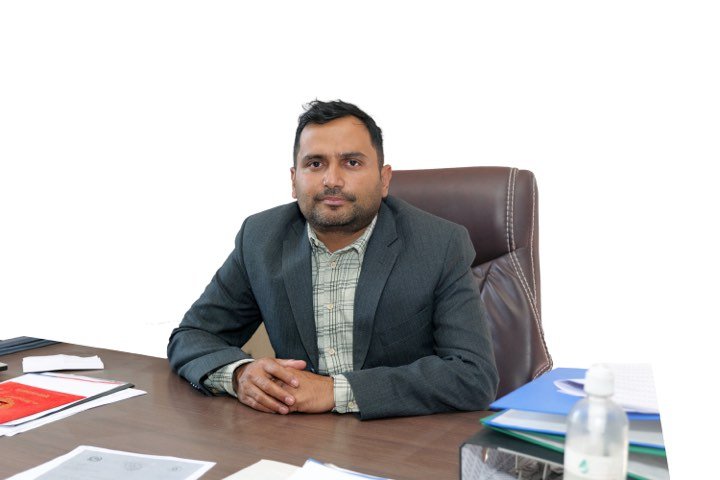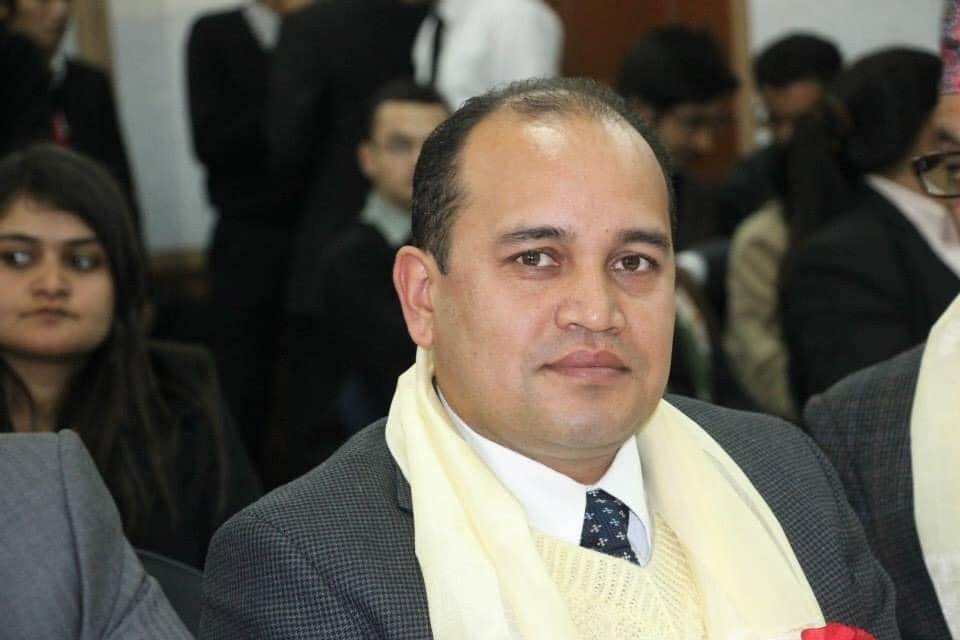Herald Fuses STEAM Education with Personalized Learning for Holistic Student Development

Binod Regmi is an experienced professional in the education sector, who is currently serving as the Principal at Herald Secondary School and Herald International College. The educational institutions under his leadership promote the values of respect for others and the recognition of individual skills and talents in children.
Mr. Regmi strongly believes that for progressive education to be successful, schools must implement personalized learning, allowing students to work at their own pace and focus on their individual interests and strengths. In a recent conversation with College Readers, he shared his views on the same. Here are some excerpts from the interview:
How does your school assess student learning and progress?
There are a variety of ways in which our progressive school assesses student learning and progress. Rather than relying solely on traditional exams and grades, we also use project-based assessments, formative assessments, portfolios, Self-Assessment and Reflection, Inquiry-Based Assessments, and peer assessments. These methods allow students to demonstrate their understanding and skills in a more authentic and meaningful way.
We also prioritize personalized learning and differentiated instruction, so our assessments are tailored to meet each student's unique needs and abilities. This helps ensure that all students are able to show their knowledge and growth in ways that work best for them.
Furthermore, we emphasize a growth mindset and encourage students to see assessment as a tool for learning and improvement, rather than just a measure of their success. This helps foster a positive and empowering approach to assessment that supports students in reaching their full potential.
Overall, our school's assessment practices are designed to be inclusive, flexible, and supportive of student growth and development progressively and holistically.
Can you describe any unique programs or initiatives the school has implemented to enhance the quality of education offered?
One unique program that the Herald School has implemented to enhance the quality of education is their STEAM (Science, Technology, Engineering, Arts, and Mathematics) program through the Next-Gen Curriculum mutually collaborative with NEB curriculum and Next-Gen USA-based education. This program integrates these diverse subjects to provide students with a well-rounded education that emphasizes critical thinking, creativity, and problem-solving skills. Through hands-on projects and real-world applications, students are able to see the connections between different disciplines and develop a deeper understanding of how they work together.
Additionally, the Herald School has implemented a personalized learning approach that allows students to work at their own pace and focus on their individual areas of interest and strength. This approach helps to ensure that each student receives a tailored education that meets their unique needs and helps them reach their full potential.
The school also places a strong emphasis on social and emotional learning, with programs in place to support students' mental health and well-being. This holistic approach recognizes the importance of developing not only academic skills but also social and emotional competencies that are crucial for success in school and life.
Overall, the Herald School's commitment to innovation and progressive education practices sets it apart as a leader in providing a high-quality, well-rounded education for its students based on a next-generation curriculum and a progressive approach.
What steps does the school take to personalize learning and meet the individual needs of students?
Herald schools typically prioritize personalized learning to meet the individual needs of students. Here are some steps they might take to achieve this:
- Conducting student assessments to determine each student's strengths, weaknesses, learning styles, and interests.
- Creating individualized learning plans for each student based on assessment results.
- Providing a variety of learning resources and materials to accommodate different learning styles and preferences.
- Offering personalized support and guidance from teachers and counselors to help students set goals and track their progress.
- Allowing students to work at their own pace and providing opportunities for self-directed learning.
- Implementing technology tools and resources to facilitate personalized learning and adapt to students' individual needs.
- Offering flexible learning environments, such as small group instruction, one-on-one tutoring, and project-based learning, to accommodate different learning preferences.
- Encouraging student voice and choice in their learning by allowing them to choose topics of interest, projects, and activities.
- Providing ongoing feedback and assessment to monitor students' progress and make adjustments to their learning plans as needed.
- Collaborating with parents, guardians, and other stakeholders to ensure that students' individual needs are met and supported both in and out of the classroom.
How does the school foster a positive and inclusive learning environment for all students?
The Herald School fosters a positive and inclusive learning environment for all students by promoting respect, empathy, and understanding among students and staff. This is achieved through:
- Diversity and multicultural education: The school celebrates and values diversity by incorporating multicultural education into the curriculum. Students learn about different cultures, traditions, and perspectives, fostering a sense of inclusion and global awareness.
- Anti-bullying and harassment policies: The school has clear policies in place to address bullying, harassment, and discrimination. This creates a safe and welcoming environment for all students, free from fear or intimidation.
- Peer mentorship and support programs: The school offers peer mentorship and support programs to help students develop positive relationships with their peers. This promotes a sense of community and belonging among students, regardless of their background or abilities.
- Inclusive teaching practices: Teachers at the Herald School use inclusive teaching practices that cater to the diverse needs of all students. This may include differentiated instruction, accommodations for students with disabilities, and culturally responsive teaching methods.
- Positive behavior support: The school implements positive behavior support strategies to encourage positive behavior and discourage negative behavior. This promotes a culture of respect, kindness, and cooperation among students.
- Community Building Activities: Herald schools prioritize community-building activities that promote collaboration, teamwork, and positive relationships among students. This may include team-building exercises, cooperative learning projects, and peer mentoring programs.
- Professional Development and Training: Teachers and staff receive training on diversity, equity, and inclusion topics to ensure they have the knowledge and skills to create a positive and inclusive learning environment. This may include workshops, seminars, and ongoing professional development opportunities.
- Restorative Practices: Instead of punitive measures, herald schools may use restorative practices to address conflicts and behavior issues. This approach focuses on repairing harm, building empathy, and fostering accountability through dialogue and mediation.
Overall, the Herald School prioritizes the well-being and success of all students by creating a positive, inclusive learning environment that promotes diversity, respect, and empathy.
Can you discuss the role of parental and community involvement in supporting the school's efforts to provide quality education?
Parental and community involvement play a crucial role in supporting a school's efforts to provide quality education. When parents and community members are actively engaged in a child's education, students tend to perform better academically and socially. Here are some ways in which parental and community involvement can support schools in providing quality education:
Parental involvement: Parents are a child's first teachers and have a significant impact on their academic success. When parents are actively involved in their child's education, they can provide valuable support at home, such as helping with homework, creating a positive learning environment, and encouraging academic success. Parents can also build positive relationships with teachers and administrators, attend school events and meetings, and participate in school-related activities. This collaboration between parents and educators can help create a strong support system for students and promote their educational growth and lifelong learning.
- Community involvement: Community members, including social organizations and volunteers, can also play a vital role in supporting schools and enhancing the educational experience for students. Community involvement can take various forms, such as partnering with the school development, offering mentorship and internship opportunities, organizing educational events and workshops, and volunteering in the classroom or school activities. By working together, schools and communities can create a more enriching and inclusive learning environment for students, fostering a sense of belonging and collaboration.
In conclusion, parental and community involvement are essential components of a successful education system. By actively engaging parents and community members in the educational process, schools can create a supportive and nurturing environment for students to thrive and reach their full potential. When schools, parents, and communities work together, they can ensure that all students have access to quality education and the necessary resources to succeed.
What role do parents/guardians play in the process of identifying and resolving student problems? How does the school involve them in this process?
Parents and guardians play a crucial role in the process of identifying and resolving student problems in Herald School. They are often the first to notice changes in their child's behavior or academic performance and can provide valuable insights into the root cause of any issues their child may be facing.
Herald School involves parents and guardians in this process by maintaining open lines of communication and actively seeking their input and feedback. This can include regular parent-teacher conferences, phone calls, emails, and written progress reports. Additionally, some schools may have parent involvement committees or support groups where parents can discuss their concerns and collaborate on solutions.
When a problem is identified, the school will typically work with the student's parents or guardians to develop a resolution plan. This may involve additional support services, counseling, or specialized interventions tailored to the student's needs. By involving parents in this process, schools can ensure that all stakeholders are working together to support the students and help them succeed.
What role does technology play in the teaching and learning process at the school? How are digital tools and resources integrated into classroom instruction?
At The Herald School, technology plays a crucial role in the teaching and learning process by incorporating a progressive approach that embraces digital tools and resources. Digital tools are integrated into classroom instruction to enhance students' engagement, collaboration, creativity, and critical thinking skills.
Some ways in which technology is integrated at The Herald School include:
- Interactive boards and projectors: Teachers use interactive boards and projectors to provide visual and interactive demonstrations for concepts and lessons. This helps students better understand complex topics through multimedia presentations.
- Online resources and platforms: Students have access to online resources such as educational websites, apps, and digital libraries to supplement their learning. These resources offer personalized learning experiences and help students practice and reinforce their understanding of concepts outside of the classroom.
- Collaboration tools: Students collaborate with their peers on group projects using digital tools like Google Docs, Padlet, and Zoom. This promotes teamwork, communication, and problem-solving skills among students.
- Flipped classroom approach: The school implements a flipped classroom approach where students watch lectures or instructional videos at home and engage in hands-on activities and discussions in class. This allows teachers to focus on facilitating discussion and providing individualized support to students.
- Coding and digitals: The school offers coding and digital classes as part of its curriculum to introduce students to computer programming and technology. Students learn to code robots, develop presentations, develop algorithms, and solve problems independently.
Overall, The Herald School leverages technology to create an engaging and student-centered learning environment that prepares students for the challenges of the 21st century. By integrating digital tools and resources into classroom instruction, the school empowers students to become lifelong learners and critical thinkers who are adept at using technology for their academic and professional pursuits.
How does the school promote active learning and critical thinking skills among students?
The Herald School promotes active learning and critical thinking skills among students through various methods such as:
- Encouraging student participation in class discussions, group activities, and hands-on projects that require them to actively engage with the material and think critically about the topic at hand.
- Herald schools teach students metacognitive strategies, such as goal-setting, self-monitoring, and self-reflection, to enhance their critical thinking abilities. Students learn to evaluate their own thinking processes, identify misconceptions, and adjust their strategies accordingly, fostering a deeper understanding of their learning.
- Providing opportunities for students to work collaboratively with their peers to solve problems, analyze information, and think creatively.
- Incorporating real-world examples and case studies into the curriculum to help students apply theoretical concepts to practical situations and develop their critical thinking skills.
- Encouraging students to ask questions, challenge assumptions, and explore different perspectives in order to foster a deeper understanding of complex issues.
- Teachers use Socratic questioning techniques to stimulate critical thinking and engage students in deeper discussions. By asking open-ended questions that prompt analysis, evaluation, and reflection, teachers encourage students to think critically, articulate their ideas, and consider multiple perspectives.
- Using technology and multimedia resources to enhance the learning experience and stimulate student interest in the subject matter.
- Offering extracurricular activities such as debates, research projects, and competitions that promote critical thinking and problem-solving skills outside of the classroom.
- Providing feedback and guidance to students on their performance, encouraging them to reflect on their learning process and continuously improve their critical thinking abilities.





